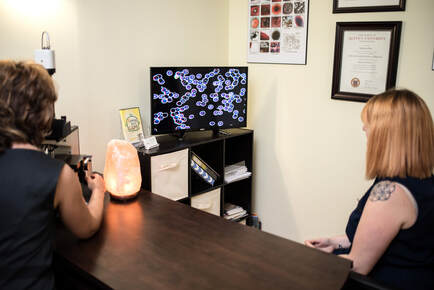Live Blood Cell Analysis
|
Live Blood Cell Analysis is an assessment tool where a drop of blood is examined under a darkfield microscope. The resulting image is displayed on a monitor, allowing both the client and practitioner to instantly observe the test results.
What makes Live Blood Cell Analysis unique?
Live Blood Cell Analysis differs from conventional medical blood testing, where preserved blood is dispatched to a laboratory for chemical composition and cell counts. Unlike traditional methods, this approach examines blood cells, which live for at least 20 minutes, uncovering certain attributes often overlooked by standard laboratory blood tests. |
Our blood plays a crucial role in transporting vital nutrients and oxygen to every cell in the body, while also removing waste metabolites to the liver and kidneys for elimination. As a result, the state of red and white blood cells, platelets, and specific indicators in the blood plasma offers valuable insights into the functionality of our internal environment.
Live cell microscopy holds potential in the initial assessment of environmental sensitivity, imbalanced terrain, compromised immunity, and other conditions, often providing information before real symptoms manifest.
Subsequently, Live Blood Cell Analysis serves as an educational "feedback mechanism," inspiring individuals to implement nutritional and lifestyle changes. Additionally, it offers insights into one's progress, as enhanced nutrition has a noticeable impact on blood quality.
What can Live Blood Cell Analysis show?
Do you have any question regarding Live Blood Cell Analysis? Contact me for a complimentary 25-minute Discovery Session!
Live cell microscopy holds potential in the initial assessment of environmental sensitivity, imbalanced terrain, compromised immunity, and other conditions, often providing information before real symptoms manifest.
Subsequently, Live Blood Cell Analysis serves as an educational "feedback mechanism," inspiring individuals to implement nutritional and lifestyle changes. Additionally, it offers insights into one's progress, as enhanced nutrition has a noticeable impact on blood quality.
What can Live Blood Cell Analysis show?
- The condition of red blood cells
- Low oxygen levels and poor circulation
- Inflammation
- Dehydration
- Liver congestion
- Immune system function
- Poor digestion of proteins and fats
- Hormonal imbalances
- Vitamin and mineral deficiencies
- Fungal forms or bacteria
Do you have any question regarding Live Blood Cell Analysis? Contact me for a complimentary 25-minute Discovery Session!
